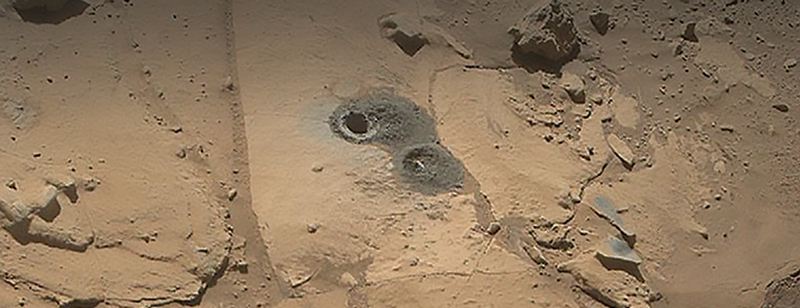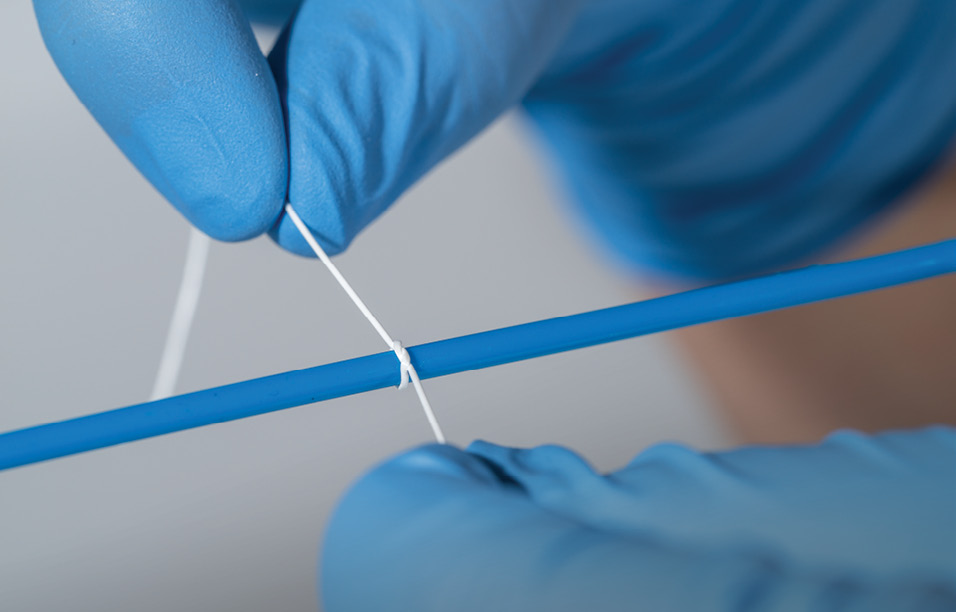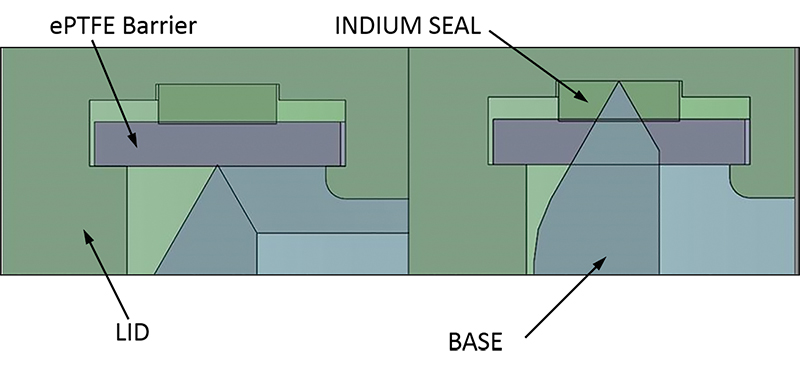
Material for Mars Makes Life-Saving Sutures
NASA Technology
Although NASA has sent many missions to Mars, nothing, so far, has ever come back. That’s something the Agency hopes to change—and it is working on the technology needed to make it happen. These innovations are already paying dividends on Earth, including a new twist on a well-known material that can now be used to stitch up hearts during surgery.
For NASA, “the mission to return samples from Mars has been at the top of the planetary science to-do list for some time,” says Andy Spry, who worked at the Jet Propulsion Laboratory (JPL) during this project and is now a senior scientist at the SETI (Search for Extraterrestrial Intelligence) Institute and supports NASA’s Office of Planetary Protection.
“Rather than being constrained by the limitations of how much hardware we can deliver to Mars, we can apply all of the hardware, all of the knowledge on Earth, to a Mars sample that’s brought back,” he says.
But any sample canister needs a strong seal, both to keep Earth’s atmosphere from contaminating the sample, and to protect Earth from any potential contamination from Mars.
“The trouble is, when you’re getting out a sample, it’s typically very dirty,” explains engineer Scott Stanley. “Drilling into a rock, you contaminate everything around you with debris.” If Martian dust gets everywhere, the lid might not seal correctly.
Stanley, vice president of technology at a small company called Techno Planet Inc., was working on a seal, based on an award from NASA, that aimed at a leak rate “measured at the molecular level, in terms of what’s getting in and out,” he recalls. “No existing seal could meet that in a contaminated environment.”
He wanted to use a “knife-edge seal,” where the stainless steel edge of the canister-base cuts into a soft metal, in this case indium that fills a lip around the lid. However, if the “knife edge” is covered in dirt, that would get stuck in the soft metal, leaving gaps and preventing a seal.
Stanley had a plan: a barrier layer that covers the soft metal. When the edge pushes through that barrier, it would be wiped clean.
“The trouble was,” Stanley says, “I was very limited on the materials choices by the science requirements.” Among other requirements, he needed something qualified for space use, that doesn’t emit gas that could contaminate a sample, and that could be completely sterilized before launch. “The only material I could use was some form of PTFE,” or polytetrafluoroethylene, which is more commonly known as Teflon.
Technology Transfer
While most people are familiar with Teflon as a nonstick coating for pots and pans, the material has other uses and other forms. At first, Stanley thought he would make the barrier on his seal out of expanded PTFE (ePTFE) ribbon.
For that, Stanley turned to Orangeburg, South Carolina-based Zeus Inc., using funding from the Small Business Innovation Research contract he’d been awarded by JPL for the project. However, when the company sent samples, they didn’t work as Stanley had hoped.
“The ePTFE, before the knife would be able to cut through it, the soft metal of the seal started squeezing out from underneath,” even after multiple prototypes and tests, he says.
But Zeus wasn’t ready to give up. ePTFE ribbon is made with a calendaring process—the PTFE is expanded and then flattened to make it thinner and stronger, but that also makes it stiffer, explains global market manager Jason Fant. “Basically, we needed to keep the favorable characteristics but to lose the side effect of making it stiffer.”
They decided to ditch the calendaring approach and try to create an ePTFE ribbon in a different way: through a large-diameter extrusion, “kind of like a Play-Doh Fun Factory,” Fant jokes.
PTFE starts as a powder, explains global business development manager Wayne Black, and the company creates unique extrusions with that powder. “PTFE powder is compressed at high pressures into a ‘preform’ at ambient temperature. That preform is then forced under high pressure through a finishing die in a customized extruder to create the finished part,” Black says. By creating different heat processing zones, he adds, “we can stretch the material to give it unique properties.”
The extruded ePTFE ribbon worked, and Stanley was thrilled. “Zeus was awesome—they’re a huge company, and here they are running these small, custom runs for me,” he recalls.
It was a significant investment of development time and dollars for what amounted to a very small sale to Stanley—but Zeus says it paid off. Altogether, it says, sales in PTFE ribbon, with both ePTFE and extruded PTFE combined, went up by double digits, with an increase of about 50 to 60 percent in the types of applications where the ribbon is used.
Benefits
So what are those applications? There are plenty, says Black, but one of the most surprising—and life-saving—is in the human body.
“This material is unique, because it’s soft, flexible, and strong—and it’s also biocompatible. It’s a material that can safely interact in the body and can be safely implanted in the body,” Black notes.
One product Zeus sells is extruded ePTFE sutures. “Let’s say you had a heart condition that would be a ripe application for something like that, maybe mitral valve repair,” Black says. “You don’t have to go back in to take the stitches out. They can just stay there.”
Likewise, the material is used to encapsulate stents that are also used in heart surgeries, he adds.
But it’s also used in fiber optics and aerospace, he says, including at NASA: a space cable on the International Space Station uses the material.
For many other applications, Black says, “the key to the material has always been that you’re creating pores on the submicron level, which allows gas to move freely but not liquid.” That makes it a great material for desiccant packaging aids—some of Zeus’ customers use these when they ship sensitive electronics, for example.
In a similar way, oil and gas drilling companies use the material to help find places to drill. “They make a pouch and bury it in the ground. Their ‘secret salt’ that they put inside the pouch attracts and absorbs hydrocarbon vapor,” explains Fant. “After they dig it up, they’ll run it through a spectrometer, and it’s like a map of where hydrocarbons are coming up and at what rate. And that helps them pinpoint where to point the drill.”
Ultimately, says Fant, this is why the company didn’t hesitate to do the work Stanley needed for his seal, because from a business perspective, “once you have that base material you can create different things in very different ways and explore new frontiers—literally.”
Spry, back at SETI, calls these results “almost extraordinary, heartwarming.
“What was a small amount of money to NASA was a lever for Techno Planet to help them, it was a large contract for them at the time,” he notes. “But alongside that, to know that a larger organization, Zeus, has actually gotten innovation out of the project—somebody was looking at what Scott was doing and saying, ‘Oh, we have these problems in this other industry, we can use it to solve them.’ That’s how technology should work.”

Extruded ePTFE is soft, flexible, and strong, and because it is biocompatible, it does not need to be removed, making it ideal for use in the human body. Among other applications, Zeus has used the material to encapsulate arterial stents.

To make a material tough enough to wipe off all the dust but soft enough that the metal base could cut through, Zeus Inc. needed to innovate. The resulting material has been used in a variety of applications, including as sutures for procedures like heart surgery.

This diagram shows a lid specially designed for a Mars sample return mission. To ensure no Mars dust interferes with the seal, the edge of the base first pushes through an extruded ePTFE barrier to wipe it clean, before it sets in a layer of soft indium metal, which ensures nothing gets in or out.

This photo by NASA’s Curiosity rover shows the Windjana rock site, where the rover’s tools drilled down for a sample to analyze. NASA learns a lot from these rovers, but it could learn even more by bringing a rock sample home for deeper analysis in Earth-based labs.













